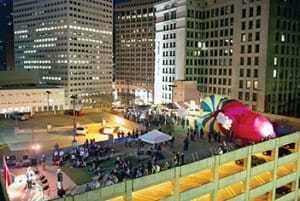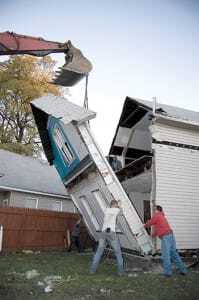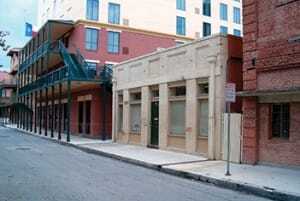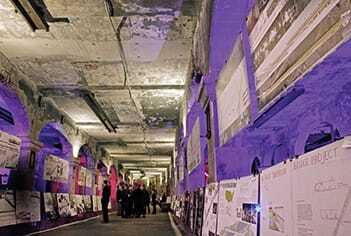For the architecture business in the United States, the Great Recession was, in the moderate word used by the American Institute of Architects (AIA), “destructive.” Revenues at architecture firms plunged more than 40 percent from 2008 to 2011, and 28 percent of all architecture jobs disappeared during roughly the same period, according to AIA figures. Through all this, though, one segment of the building design and planning profession managed to grow and become more influential: urban design centers.
Design centers are small agencies or groups—typically with the word design in their name—that focus on downtown aesthetics and the walkability of public and some private spaces, one project at a time. No two design agencies are the same, but their work can include reviewing building plans, enforcing design guidelines, proposing streetscapes and parks, promoting redevelopment opportunities, and sometimes working for private developers. Basically, urban design centers act as a cross between a city codes department and a civic booster organization. Think of them as gatekeepers of the urban built environment.
“There’s an equation that good design equals good economic development, that well-designed projects create a sense of place,” says Mark Brodeur, executive manager of the City Design Center in San Antonio. “So I like to say that we bring added value to the urban environment. We’re not going to redesign cities or change cities, but we incrementally bring added value to projects that come forward.”
The Association of Community Design, a nonprofit umbrella network of architectural design centers, reports that design agencies exist in more than 35 major U.S. metropolitan areas. Several have been around since the 1990s or before, but many have formed since the turn of the century. Nearly a dozen centers have been launched just since 2007, including those in big cities like Dallas and Los Angeles; midtier cities like Columbus, Ohio, and Memphis, Tennessee; and even suburbs like Arlington, Texas, outside Dallas.
They generally have budgets of a few hundred thousand dollars and are structured in one of three ways:
- Some are part of a city government, typically as a unit of a planning department involved in zoning policies and building standards. San Francisco’s City Design Group, for example, developed the city’s Better Streets Plan for streetscapes surrounding new developments, and the Urban Design Studio in Los Angeles created a walkability checklist for building projects.
- Some centers are affiliated with a university’s architecture school, so they use staffs of students to work on community design needs.For example, the Kansas City Design Center in Missouri—affiliated with the University of Kansas and Kansas State University—created a new vision for an underused downtown park, which the city government decided to fund. In Ohio, the Cleveland Urban Design Collaborative (CUDC), affiliated with Kent State University, stages temporary events in vacant downtown buildings to attract investment interest.
- Some design groups are independent nonprofits that are self-funded and agents of change, offering ideas and guidance to public officials. In Dallas, the CityDesign Studio created architectural guidelines that the city council adopted for a neighborhood near downtown; in Tennessee, the Memphis Regional Design Center offers courses to civic leaders on the importance of a well-designed public realm.
What is driving the emergence of these centers, according to planning and design advocates, is the public’s growing interest in place making, especially in urban areas. Downtowns are growing in population again after decades of decline, and their new residents desire and demand cohesive, walkable, and attractive urban environments. And the public realm usually establishes the paradigm and the environment for private investment interest.
As Simon Pastucha, a city planner who directs the Urban Design Studio in Los Angeles, explains, “We’re starting to see better-designed projects, and it’s helping the development community know what the city’s expectations are for design.”

From the Hipp Deck event, CUDC borrowed a parking garage on the former site of the Hippodrome Theater in Cleveland-the largest, most opulent theater between New York City and Chicago until it was demolished in the 1970s to make way for the parking structure. CUDC programmed the parking garage for one night with theatrical uses-opera, movies, music, and snacks. The inflatable structure was created bu Cleveland artist Jimmy Kuehnle. (Matthew Fehrmann)
Advocacy Role
Last summer in Arlington, a grease fire destroyed units at the Spanish Park Apartments, a nearly 50-year-old complex of mostly two-story buildings that resembled older motels. Some city leaders pressured the owner not to simply rebuild the units but to improve the site, and as an incentive they suggested working with a free service, the Arlington Urban Design Center.
The center is a partnership between the city and the architecture school at the University of Texas at Arlington. Its staff of one city planner and graduate-student interns visited the vacant building site, held meetings, and prepared a reuse plan tailored to the residents’ needs for parking and children’s play space. The owner followed the plan, building more than 20 additional parking spaces, a fenced-in mini–soccer court, a sandbox, and benches. The project was completed this past spring.
“It’s now perceived as one big community play area, so it’s like the safe haven for kids,” says Rich Bilanceri, a real estate manager and representative of the owner, Cooper Redevelopment.
In downtown Cleveland, where vacant lots and buildings dot the landscape, the Cleveland Urban Design Collaborative takes an approach of promoting such sites one at a time. A few times a year, the collaborative takes over a vacant or underused building and holds unusual one-day events, called “pop-ups.” One time, movies were shown at a parking garage; another time, a warehouse was turned into a roller rink.
The idea is to draw attention to—even investor interest in—the buildings while creating “happening” events in downtown Cleveland. Later, the roller-rink warehouse was bought and turned into a center for banquets and receptions.
“We think that by putting ideas in the air, it helps the real estate community in Cleveland,” says Terry Schwarz, director of the collaborative, which is part of Kent State University and has a staff of six. “It’s helping people see the potential of this latent real estate.”
In Tennessee, the Nashville Civic Design Center acts much like a separate downtown council. It studied sites for a new downtown convention center, which recently opened. It explored the concept of an elementary school downtown as a way to attract more residents. And it initiated the idea of a pedestrian bridge, now being developed, that spans railroad tracks and connects a new residential neighborhood to the center of downtown.
“We can bring all the different community groups together to be an advocate for the community,” says Julia Landstreet, executive director of Nashville’s design center. “We find the ideas and bring them to town so they turn into economic development opportunities.”
Indeed, though different design centers do different things, a theme shared by all of them is advocacy. They are activists: they encourage, support, and promote better-looking, more livable, and highly desirable places.

Among the “pop-up” events organized by CUDC was the House Inside Out project. Martin Papcin, an artist from Prague, visited Cleveland to turn a house slated for demolition inside out-slicing the walls off the structure and flipping them-dramatizing the emotional upheaval of the foreclosure crisis. When the house was inside out, the CUDC staged an event on site; a few weeks later, the city demolished the house. (David Jurca)
Design Backlash
In most cases, the real estate community is buying in. But sometimes design centers are viewed as taking their advocacy role too far.
In Los Angeles, the Urban Design Studio now provides a design vision for the city, including street standards that call for landscaping and for new buildings to have windows at the ground floor, both intended to promote pedestrian activity. But not all developers want to pay for those amenities.
“I share a concern of some architects that you can’t always legislate good design. There are projects that don’t fit a mold,” says Craig Lawson, a land use consultant in Los Angeles who has worked with the design studio on several projects. “For the most part, the idea of promoting a better pedestrian experience in downtown has made it more attractive for people to live downtown. But with individual projects, some owners have the flexibility and financing to make the improvements, but some don’t, and that can be an issue.”
In Omaha, Nebraska, earlier this year, urban design turned into a political issue.
Omaha is one of the few cities with dual multiple urban design bodies—an urban design section of the city’s planning department and an independent nonprofit called Omaha by Design, which helped craft urban design policies in the city’s master plan and zoning code. But some developers have complained that the design standards are inflexible and that the planning department’s process is needlessly lengthy, causing project delays. This frustration became a hot topic on the campaign trail during the mayoral election last spring, with one candidate declaring, “A lot of jobs are being developed outside of Omaha because they just don’t want to deal with the planning department. We chase them out.”
The newly elected mayor, Jean Stothert, who also was critical of the planning department, has promised to review the impact of the city’s urban design code and has created a task force for reshaping the department. “It’s a convenient target to complain about,” says Jed Moulton, the city’s urban design section manager.
The experience of Seattle is another cautionary tale. There, CityDesign was established as an independent entity, but in 2004 it became part of the city’s planning department—one of the first urban design centers established in a planning department.
CityDesign was visible in the city and provocative, leading plans to create pedestrian connections along the waterfront and to develop a ring of open spaces around downtown. But then its charismatic director left for another city, the mayoral administration changed, and without those political champions, CityDesign was shut down in 2011.

In downtown San Antonio, an area of largely abandoned buildings was redeveloped as the Sunset Station area of restaurants, hotels, and offices. One of the buildings repaired was the storefront which received masonry repairs, new paint, and a new awning, and now houses an engineering company. (San Antonio City Design Center)
Urban design is still practiced in different departments of Seattle’s government, just not facilitated through CityDesign. “It was flashy and autonomous, and maybe it turned out to be too much so,” says Lyle Bicknell, the principal urban designer in Seattle’s planning department. “You’re somewhat dependent on the quality of the director and the political winds of support.”
There are lessons, then, for urban design agencies across the country. Though the public’s interest in and appetite for attractive urban environments continue to grow, with a result being creation of more design centers in more cities, the countervailing trend that involves rising skepticism toward government planning in general means design centers need to be careful in how they pursue and implement their goals.
“Nobody wants to be told what to do,” says Sarah Abel, president of the Association for Community Design. “There are many different roles that community design centers take on, and it’s important that they work from the ground up, not the top down. But they’re a resource that no one else is providing, and they’re taking on some of the most challenging problems that no one else wants to tackle.
“They’re a way to change our cities.”
Jeffrey Spivak, a senior market analyst at a Kansas City, Missouri–based engineering firm, has been writing about real estate, development, and infrastructure issues for more than 20 years.





